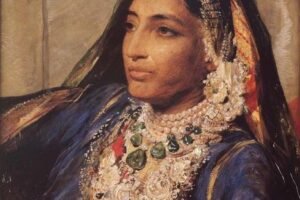What is Guru Granth Sahib?
It is a religious scripture, a compilation of spiritual/mystical hymns with a common philosophy but written by different spiritual Masters, prominent saints (Bhagats) and some other spiritualists from the Indian subcontinent. The different enlightened Beings, whose writings are included in the scripture lived between the twelfth and the seventeenth century and belonged to different faiths and classes/strata of society. This scripture is called Adi Granth (Adi means original and Granth means scripture) to differentiate it from another scripture written by the tenth Master, Guru Gobind Singh, called the Dasam Granth.
What is unique about Guru Granth Sahib?
This is the latest of the principle religious scriptures from the Indian sub-continent and is the only known scripture that contains the original writings from the Masters of a major faith known as Sikhism. The compilation of the original scripture was completed by the fifth Sikh Guru, Arjan Dev in 1604. The most unique feature of this scripture is that it contains a universal message of spiritual living for the entire human race.
Compilation of Guru Granth Sahib
The founder of Sikhism, Guru Nanak (Guru means a teacher, a spiritual guide) who lived physically from 1469 to 1539 was a mystic from early age. He traveled far and wide during his life, not only in India but also in various other Asian countries and those of Arabia, over a period of about 25 years. Thus he not only studied and interacted with the Indian culture in its minute form but with many other cultures as well. At that time Indian society was ruled by the Mughals and it mostly practiced various forms of Hinduism and Islam. However, there were very few spiritualists among the Hindus or Muslims and the society was inflicted with numerous social ills. Guru Nanak had the vision of a true spiritual life that he then preached through the mystical hymns that he composed and sang. Other Sikh Gurus, who followed Guru Nanak, also preached the same philosophy and many of them wrote mystical hymns of their own. The fifth Guru, Arjan Dev compiled Guru Granth Sahib at Amritsar, the spiritual center that he created. Besides the hymns that he wrote himself, he collected the hymns of the first four Gurus and those of many other saints/spiritualists with similar philosophy and thus compiled the Adi Granth. The volume was scribbled by Bhai Gurdas under the direction of Guru Arjan, who subsequently gave the volume to his follower Bhai Banno for binding.
The later took it to Lahore and on the way prepared a copy of the original volume. That first copy of the original is known as Bhai Banno’s copy. Guru Arjan installed the original Holy Scripture in 1604 at the Sikh temple (Harmandir Sahib) that he had got constructed at Amritsar. A highly respected Sikh from the time of Guru Nanak, Baba Buddha was appointed as the first Granthi or keeper of the scripture. After the martyrdom of Guru Arjan Dev at the hands of King Jahangir, Guru Hargobind became the sixth Sikh Guru in 1606. Subsequently Bhai Dhirmal, grandson of Guru Hargobind got hold of the scripture and refused to give it to the Guru. In 1706, the tenth Sikh Guru, Gobind Singh, while camping at Damdama Sahib recompiled Guru Granth Sahib with the help of a close associate Bhai Mani Singh by adding hymns of the ninth Sikh Guru Tegh Bahadur and gave direction to his followers to consider the scripture as the eternal Guru. Thus the scripture is called Sri Guru Granth Sahib (Guru means teacher or guide, Granth means a holy book, whereas Sri and Sahib are adjectives of respect).
Whose hymns are included in Guru Granth Sahib?
The scripture contains compositions of six Sikh Gurus (the first five Gurus and the ninth Guru), 15 saints and Bhagats (Kabir, Farid, Namdev, Ravidas, Beni, Trilochan, Jaidev, Parmanand, Sadna, Ramanand, Dhanna, Pipa, Sain, Soordas and Bhikhan); three Gursikhs Sunder, Balwand & Satta and eleven Bhattas (bards) or spiritual poets (Kalsahar, Balh, Bhalh, Bhikha, Gayand, Harbans, Jaalap, Kirat, Mathura, Nalh and Salh).
Guru Granth Sahib contains a total of 5894 hymns. 974 hymns are written by the first Guru, 63 by the second Guru, 907 by the third, 679 by the fourth, 2218 by the fifth, 116 by the ninth Guru and 541 hymns are by Bhagat Kabir. The remaining hymns are by others saints/Bhagats and poets listed above.
Composition (internal structure) of Guru Granth Sahib
The scripture in its customary form has 1430 pages. The allocation of pages is as follows: 1. Japji 1-8. 2. Musical hymns 8-1351. 3. Sloka Sahskriti 1352-1359. 4. Gatha 1359-
1361. 5. Funhe l36l-1362. 6. Chaubole 1363-1364. 7. Slokas of Kabir and Farid 1364-1384. 8. Swa-ee-ay (poetry of praise) of the Gurus by the Bhattas 1384-1408. 9. Slokas of the Gurus 1409-1428. 10. Raag Mala, the index of musical measures 1429-1430.
Most of the hymns in Guru Granth Sahib are classified according to musical forms called ragas. Under each raga, the hymns are further arranged in the following order:
1. Chaupadas – hymns of four verses.
2. Ashtapadas – hymns of eight verses.
3. Long poems.
4. Chhants – Verses of six lines.
5. Short poems.
6. Vaars – consisting of two or more Slokas and a Pauri.
7. Hymns of Bhagats in the same order.
The hymns are further classified according to the musical clef (Ghar) in which each is to be sung. Although according to the index of ragas in Raag Mala, the total number of ragas and Raaginis is 84, and only 31 have been used in Guru Granth Sahib.
Conclusively the Granth is arranged firstly according to the raga; secondly, according to the nature or meter of the poem; thirdly by authorship and fourthly by the clef.
What kind of philosophy do the hymns in Guru Granth Sahib reveal?
Guru Granth Sahib is a treasure of divine knowledge, mysticism and a guide to a spiritual living for anyone, who ventures to find instruction from it and live by it. The hymns help us with unwavering belief in God. A description of God is given in the opening sentence of Guru Granth Sahib, which is called Mool Mantra (basic creed) and is a preamble to the first section called Japji:
Ik Omkaar satnaam kartaa purakh nirbhao nirvair Akaal moorat ajoonee saibh’ng gurparsaad. (1)
(God is One, Truth is His Name, He is the Creator, Fearless, without Enmity, the Immortal, Self-illumined and is Obtainable by the Grace of Guru.)
We are guided to live a family life and make a truthful living and share the earnings with the less fortunate beings. According to the hymns ‘spirituality’ means love for God and his creation, humility/sweetness, empathy/compassion for others, a feeling of brotherhood with the entire mankind, contentment, forgiveness, devotion to selfless service of others, sharing resources with those in need, truthful and honest living, to be thankful of God’s gifts (that will be many if we count), doing one’s best, staying on the right spiritual path and leaving the result to Him and accepting His divine will.
The hymns teach us that the following human attributes take us away from the path of spirituality: anger, arrogance, self-righteousness, hate/animosity, bigotry, apathy/unconcern for others, being punitive, greed, attachment with worldly goods or beings, lust and falsehood/corruption. The hymns also give us several directions viz. to shed barriers that divide the human race, such as racism and the caste system. In short, Guru Granth Sahib, is the epitome of spiritual bliss and communal harmony.












